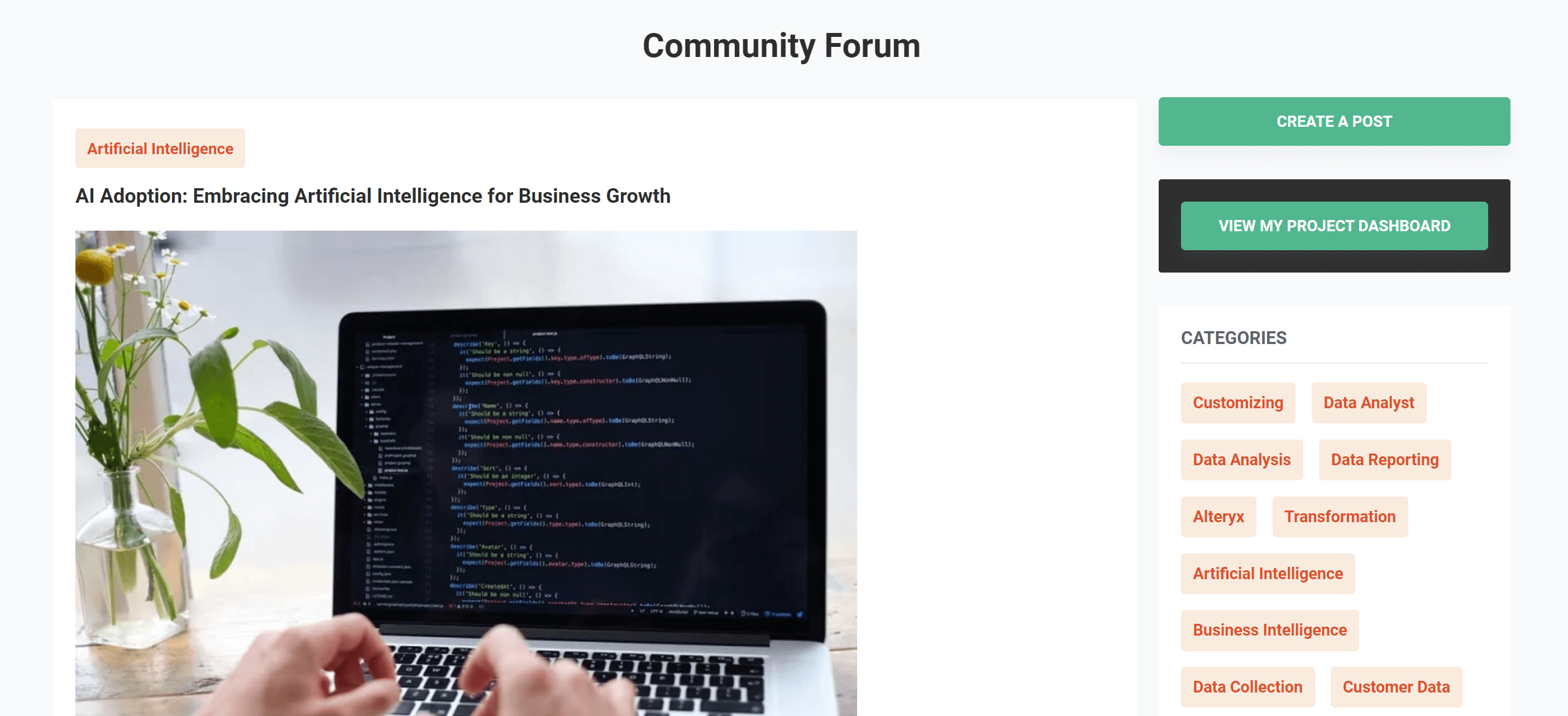Unlocking Success with Business Intelligence Dashboards

Table of Content
- What Are Business Intelligence Dashboards?
- Advantages of Using BI Dashboards in Businesses
- Key Features of Effective BI Dashboards
- BI Dashboards vs. Traditional Reporting: Advantages in the Data-Driven World
What Are Business Intelligence Dashboards?
A business intelligence (BI) dashboard is a tool in the BI arsenal, designed to showcase data visualizations and analytics on a single screen, facilitating effortless referencing for reporting and decision-making needs. These dashboards are intentionally versatile, allowing users to tailor them to display crucial key performance indicators (KPIs) and other relevant metrics.
In most cases, BI dashboards establish connections with data sources, such as databases or data warehouses, ensuring they can receive real-time updates with the latest information for business users. The underlying software of the dashboard works its magic by converting raw data into easily comprehensible data points and visual representations, empowering decision-makers with actionable insights.
Advantages of Using BI Dashboards in Businesses
Business Intelligence (BI) dashboards have revolutionized the way businesses operate, offering a multitude of advantages that contribute to their success in today’s data-driven world. Here are the key benefits of using BI dashboards:
1. Improved Decision-Making: BI dashboards provide a real-time, comprehensive view of critical data. This access to up-to-the-minute information empowers decision-makers to make informed choices swiftly. By offering insights at a glance, these dashboards enable a deeper understanding of performance, market trends, and customer behavior, leading to better, data-driven decision-making.
2. Enhanced Efficiency: The automation of data collection, analysis, and presentation within BI dashboards reduces the time and resources required for manual data processing. This efficiency allows employees to focus on value-added tasks, such as interpreting data and devising strategies, rather than data compilation and reporting.
3. Competitive Advantage: In today’s competitive landscape, businesses that can quickly respond to changing conditions gain a significant edge. BI dashboards provide the ability to monitor KPIs, track market shifts, and adapt strategies accordingly. This agility leads to a competitive advantage, as companies can proactively adjust their actions based on real-time data.
4. Data-Driven Insights: BI dashboards offer an array of data visualizations and analytics, simplifying the interpretation of complex information. This means that even non-technical users can gain insights from data without the need for specialized training. This democratization of data allows employees at all levels to contribute to decision-making.
5. Customization: BI dashboards are highly customizable. Users can tailor their dashboards to display the specific data and KPIs that matter most to their role or department. This adaptability ensures that each user sees precisely what they need, increasing relevance and usability.
6. Collaboration: BI dashboards promote collaboration by enabling teams to work with the same data source. This alignment ensures that everyone within an organization is on the same page, reducing miscommunication and promoting collective efforts to achieve common goals.
7. Early Issue Detection: The ability to track KPIs and performance in real-time allows for early detection of potential issues. This proactive approach means that problems can be addressed swiftly, minimizing their impact on operations and customer satisfaction.
8. Customer Insights: BI dashboards are invaluable for understanding customer behavior and preferences. By tracking customer data, businesses can tailor their products and services to meet customer needs, improving the overall customer experience.
9. Accountability: The transparent nature of BI dashboards, with KPIs and targets clearly displayed, holds teams and individuals accountable for their performance. This encourages responsibility and can lead to increased productivity.
Key Features of Effective BI Dashboards
Business Intelligence (BI) dashboards are invaluable tools for organizations seeking to make data-driven decisions and gain actionable insights. To be truly effective, BI dashboards should possess a range of essential features and characteristics that facilitate the delivery of meaningful insights. Here are the key elements that make a BI dashboard effective:
Real-Time Data Integration: Effective BI dashboards connect to data sources in real time, ensuring that the information displayed is up-to-date and relevant. This feature is critical for making timely decisions.
User-Friendly Interface: An intuitive and user-friendly interface is essential. Users, regardless of their technical background, should be able to navigate and interact with the dashboard effortlessly.
Customization: Customizability allows users to tailor the dashboard to their specific needs. They can select the data, KPIs, and visualizations that are most relevant to their roles and goals.
Data Visualization: Effective dashboards utilize a variety of data visualizations, such as charts, graphs, and maps, to present data in an engaging and easy-to-understand manner. Visual representations simplify complex information.
Interactive Elements: Interactive elements like filters, drill-down options, and hover-over details empower users to explore data and gain deeper insights by interacting with the dashboard.
Mobile Responsiveness: In a mobile-centric world, a responsive design that adapts to different screen sizes is crucial. This ensures that users can access insights on the go.
Alerts and Notifications: Dashboards should be capable of sending alerts or notifications when KPIs reach predefined thresholds. This feature allows users to respond quickly to significant changes.
Data Security: Effective BI dashboards prioritize data security. They often include features like user authentication, data encryption, and compliance with data protection regulations.
Drill-Down Capabilities: Users should be able to drill down into specific data points to investigate underlying factors contributing to KPI changes, helping them pinpoint areas for improvement.
Performance Optimization: To ensure a smooth user experience, effective BI dashboards are optimized for performance. They load quickly and handle large datasets efficiently.
Collaboration Tools: The ability to share insights and collaborate with team members is vital. Features like data sharing, commenting, and collaboration within the dashboard enhance teamwork.
Scalability: As organizations grow, the dashboard should be scalable to accommodate more data sources, users, and data points.
Data Governance: An effective BI dashboard supports data governance by allowing administrators to control access to sensitive information and manage user permissions.
Integration with Other Tools: The dashboard should be capable of integrating with other software and data sources, creating a unified ecosystem for data management and analysis.
Training and Support: Access to training materials, documentation, and customer support ensures that users can maximize the potential of the dashboard.
BI Dashboards vs. Traditional Reporting: Advantages in the Data-Driven World
In the ever-evolving landscape of data-driven decision-making, the battle of BI Dashboards vs. Traditional Reporting has become increasingly relevant. While both methods serve the purpose of delivering insights, BI dashboards exhibit clear advantages that set them apart as the superior choice in today’s data-centric world. Here’s a comparison highlighting their respective strengths:
Real-Time Data Access:
- BI Dashboards: Dashboards offer real-time data access, providing insights as they happen. Users can monitor KPIs and make immediate decisions.
- Traditional Reporting: Traditional reports are typically generated periodically, which means the data can quickly become outdated, limiting their usefulness in dynamic environments.
Data Visualization:
- BI Dashboards: Dashboards incorporate data visualization elements like charts and graphs, making complex data easier to understand and interpret.
- Traditional Reporting: Traditional reports rely on text-heavy formats, making it harder to grasp trends and patterns within the data.
Customization:
- BI Dashboards: Users can customize dashboards to display the specific data and KPIs relevant to their roles and goals, increasing relevance and usability.
- Traditional Reporting: Traditional reports have a fixed structure, making them less adaptable to individual needs.
Interactivity:
- BI Dashboards: Dashboards are interactive, allowing users to explore data, apply filters, and drill down into specific details for deeper insights.
- Traditional Reporting: Traditional reports are static documents with limited interactivity, making it challenging to investigate data further.
Accessibility:
- BI Dashboards: Dashboards can be accessed from anywhere with an internet connection, promoting accessibility and collaboration among team members.
- Traditional Reporting: Traditional reports often require physical distribution or email, leading to delays and reduced accessibility.
Agility:
- BI Dashboards: Dashboards support agile decision-making, enabling quick responses to changing conditions and emerging opportunities.
- Traditional Reporting: Traditional reports are less conducive to agile decision-making due to their static nature.
Collaboration:
- BI Dashboards: Dashboards allow for real-time collaboration within the platform, fostering teamwork and alignment.
- Traditional Reporting: Traditional reports require separate communication channels for collaboration, potentially leading to miscommunication.
Early Issue Detection:
- BI Dashboards: Real-time monitoring in dashboards facilitates early issue detection, allowing problems to be addressed swiftly.
- Traditional Reporting: Traditional reports may not provide timely alerts for emerging issues.
In the data-driven world we live in, BI dashboards stand out as the superior choice due to their real-time data access, visualization capabilities, customizability, interactivity, and accessibility. They empower organizations to respond swiftly to changing conditions, make informed decisions, and collaborate effectively – all critical components of success in the modern business landscape. While traditional reporting methods still have their place, the advantages of BI dashboards position them as the frontrunners in the race for data-driven excellence.
Get your data results fast and accelerate your business performance with the insights you need today.



